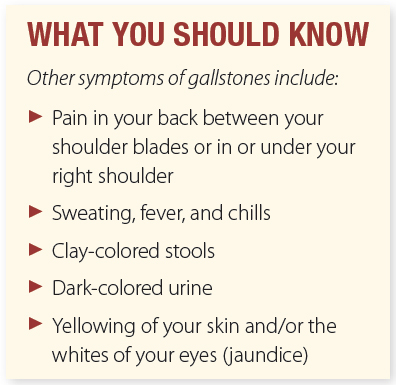For Painful Gallstones, Gallbladder Removal May Be Necessary
Your gallbladder is a small, pear-shaped organ located on the right side of your abdomen beneath your liver. Your gallbladder stores bile that is produced by your liver. When you consume foods that contain fat, your gallbladder releases bile into ducts (tubes) that carry the bile to your small intestine, where it assists in the breakdown of fat. Bile is a fluid that contains water, acid, cholesterol, bilirubin, and lecithin.
“Most gallstones are made of cholesterol, calcium salts, and bile,” says Rasa Zarnegar, MD, an associate professor of surgery at Weill Cornell Medicine. “A majority of people have gallstones, but most do not have any symptoms.”
Why Gallstones Form
The most common type of gallstones form when your liver excretes more cholesterol than your gallbladder can dissolve; the excess cholesterol can clump and form into hard particles, which gather more cholesterol, become larger, and eventually turn into stones. Gallstones also may form if your gallbladder does not empty completely or if your bile contains too much bilirubin.
A gallstone may be as small as a grain of sand or as large as a golf ball. If a gallstone becomes lodged in a duct, it can block the flow of bile and cause your gallbladder to become inflamed.
“Symptoms include abdominal pain, nausea, and vomiting. Sometimes, these symptoms start after a greasy meal, and they can last for several hours,” explains Dr. Zarnegar. “It is important to alert your doctor immediately if the pain does not go away after four to six hours, as this may require emergency surgery.”

Diagnostic Tests
If your doctor believes that you may have gallstones, he or she will probably order an abdominal ultrasound and/or a computed tomography (CT) scan. These tests create images of your gallbladder that can be examined for signs that gallstones are present. Other tests may help your doctor determine whether a gallstone is causing a blockage in your bile ducts. In these tests, a special dye is used to highlight your bile ducts.
Treatment Options
If you have gallstones that are causing symptoms, the most common treatment is cholecystectomy, or gallbladder removal. In most cases, the surgery is performed laparoscopically through small incisions in the abdomen and/ or navel (belly button). As with most surgeries, there is a small risk of bleeding and infection. If the surgeon discovers that scarring is extensive and/or the inflammation is severe, a more extensive surgery may be performed to ensure safety and minimize complications.
Following laparoscopic surgery, patients usually go home the same day and are able to resume all normal activities in a couple of days, with the exception of heavy lifting, which is prohibited for four weeks to allow for healing.
For many medical conditions, medication is the first line of treatment, and surgery is done only if all other treatment options fail. However, the reverse is true for gallbladder disease.
“Medications for gallbladder disease typically do not work,” explains Dr. Zarnegar. “There are some drugs that may dissolve the stones, but they are ineffective for most patients, and medication is an option only when the patient is unable to undergo surgery.”
Increased Risk
Factors associated with a higher risk of gallstones include:
- Having a family history of gallstones
- A diet high in fat and/or cholesterol and low in fiber
- Being overweight or obese
- Being female
- Taking medications that contain estrogen, such as birth control pills or hormone therapy drugs
- Being age 60 or older
- Having diabetes
- Being an American Indian or a Mexican American
If you have any of these risk factors, share that information with your doctor.
Dietary Changes May Help
Eating more plant foods and less red and processed meat can help prevent gallstones.
“A diet high in fiber and low in saturated fat keeps bile cholesterol in liquid form, which prevents gallstone formation,” advises Dr. Zarnegar. “In some studies, olive oil has been shown to reduce the risk of gallstones by helping reduce cholesterol levels in the blood and gallbladder.”
The post For Painful Gallstones, Gallbladder Removal May Be Necessary appeared first on University Health News.
Read Original Article: For Painful Gallstones, Gallbladder Removal May Be Necessary »

